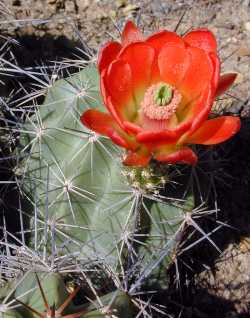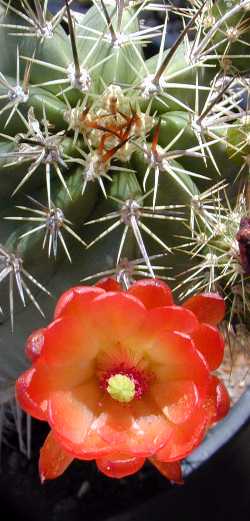Claret Cup, Strawberry Cactus
Scientific Name: Echinocereus triglochidiatus Engelmann
Synonym: Echinocereus triglochidiatus var. paucispinus
Family: Cactaceae
Sunset®: 10-13
USDA: 7-10
Frost Tolerance: Depends on the variety, var. arizonicus is hardy to 20° F (-6° C), the other varieties are much more cold resistant
Heat Tolerance: Needs some shade in Phoenix in summer
Sun Exposure: Full sun, afternoon shade
Origin: Nevada, Utah, and Colorado south to southern California, Arizona, New Mexico, Texas, and Mexico
Growth Habits: Solitary, or mounds of clumping stems, the stems are up to 12 inches tall (30 cm), 6 inches in diameter (15 cm)
Watering Needs: Regular water in summer in Phoenix, minimal or none in most other places, keep drier in winter
Propagation: Seeds, offsets

Hedgehog cactus has eight to twelve spines per areole, with central spines being difficult to distinguish from radial spines. Plants may vary from densely spiny to no spines at all.
The several varieties are so different looking that the only uniting factor is the bright red bloom and rounded petals. Some authorities recognize the following varieties:
E. triglochidiatus var. triglochidiatus
E. t. var. arizonicus (Rose) L. Benson Arizona hedgehog cactus (endangered): oak woodland
E. t. var. gurneyi L. Benson : Chihuahuan desert, desert grassland
E. t. var. inermis Rowley spineless hedgehog cactus
E. t. var. melanacanthus (Engelm.) L. Benson :Rocky Mountain montane forest, pinyon-juniper woodland
E. t. var. mojavensis (Engelm. & Bigel.) L. Benson : Mojave desert, chaparral
E. t. var. neomexicanus (Standl.) Standl. ex W. T. Marshall : oak, pinyon-juniper woodland
E. t. var. paucispinus (Engelm.) Engelm. ex W. T. Marshall
The variety E. t. variety toroweapensis Fischer has been proposed.
A spineless form of E. t. var. mojavensis occurs in the mountains and mesas of western Colorado and eastern Utah.
Echinocereus coccineus is now considered a distinct species.
Blooming Habits:
The scarlet flowers are diurnal, remaining open for 2 or 3 days. They are followed by a red and juicy fruit, with deciduous spines
Desert-Tropicals is dedicated to provide gardening advice, gardening ideas, and information about flower of all kind for landscape and collections.We try to check carefully the identification of the plants on the illustrations as well as the other information from the page, but occasionally errors do occur. if you notice anything that needs to be changed please contact us.Thanks.
© 1998-2020 Philippe Faucon, All Rights Reserved.
